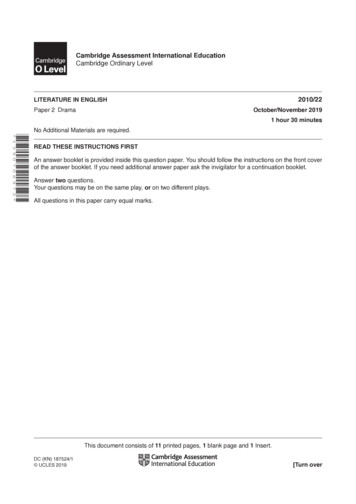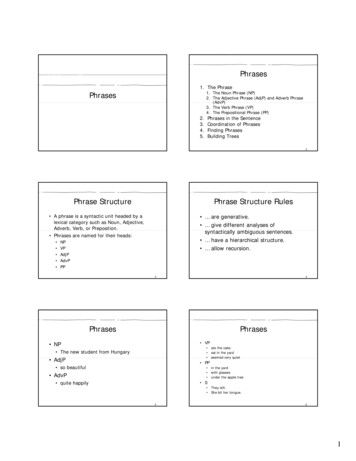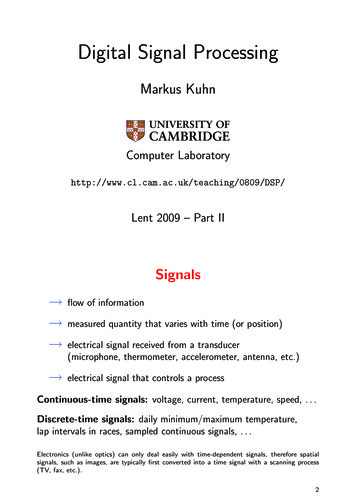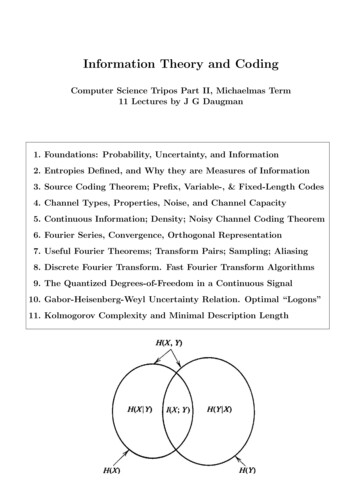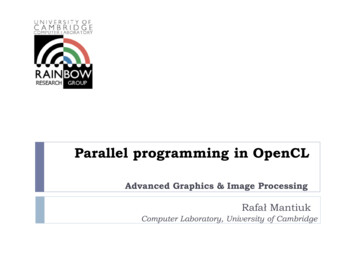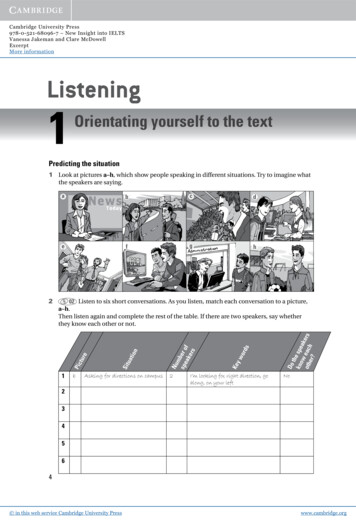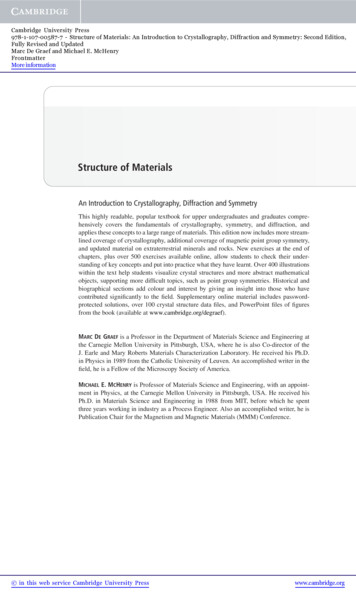
Transcription
Cambridge University Press978-1-107-00587-7 - Structure of Materials: An Introduction to Crystallography, Diffraction and Symmetry: Second Edition,Fully Revised and UpdatedMarc De Graef and Michael E. McHenryFrontmatterMore informationStructure of MaterialsAn Introduction to Crystallography, Diffraction and SymmetryThis highly readable, popular textbook for upper undergraduates and graduates comprehensively covers the fundamentals of crystallography, symmetry, and diffraction, andapplies these concepts to a large range of materials. This edition now includes more streamlined coverage of crystallography, additional coverage of magnetic point group symmetry,and updated material on extraterrestrial minerals and rocks. New exercises at the end ofchapters, plus over 500 exercises available online, allow students to check their understanding of key concepts and put into practice what they have learnt. Over 400 illustrationswithin the text help students visualize crystal structures and more abstract mathematicalobjects, supporting more difficult topics, such as point group symmetries. Historical andbiographical sections add colour and interest by giving an insight into those who havecontributed significantly to the field. Supplementary online material includes passwordprotected solutions, over 100 crystal structure data files, and PowerPoint files of figuresfrom the book (available at www.cambridge.org/degraef).MARC DE GRAEF is a Professor in the Department of Materials Science and Engineering atthe Carnegie Mellon University in Pittsburgh, USA, where he is also Co-director of theJ. Earle and Mary Roberts Materials Characterization Laboratory. He received his Ph.D.in Physics in 1989 from the Catholic University of Leuven. An accomplished writer in thefield, he is a Fellow of the Microscopy Society of America.MICHAEL E. MCHENRY is Professor of Materials Science and Engineering, with an appointment in Physics, at the Carnegie Mellon University in Pittsburgh, USA. He received hisPh.D. in Materials Science and Engineering in 1988 from MIT, before which he spentthree years working in industry as a Process Engineer. Also an accomplished writer, he isPublication Chair for the Magnetism and Magnetic Materials (MMM) Conference. in this web service Cambridge University Presswww.cambridge.org
Cambridge University Press978-1-107-00587-7 - Structure of Materials: An Introduction to Crystallography, Diffraction and Symmetry: Second Edition,Fully Revised and UpdatedMarc De Graef and Michael E. McHenryFrontmatterMore information“This book is a lucid, modern, visually attractive exposition of the fascinating and perennially useful subject of the structure of materials. With examples from various materialsclasses, it will be a valuable addition to the library of most materials scientists andengineers.”R.V. RAMANUJAN, Nanyang Technological University“The book represents more than an introduction to crystallography, diffraction and symmetry. It is a thorough work explaining the structure of materials from the basic principles ofcrystallography and the techniques of characterization including analysis of representativematerials (metals, ceramics, amorphous, molecular solids and nanomaterials). The easyreading together with the number of illustrations facilitates the understanding of complexstructures. The book is a good reference, and the inclusion of problems at the end of eachchapter makes it a very useful text book for beginners.”MARINA DÍAZ MICHELENA, Instituto Nacional de Técnica Aeroespacial“De Graef and McHenry have written a masterpiece in a rich and historical subject thatis critical in understanding many topics in materials science and engineering, chemistry,physics, and geology. They provide a comprehensive and unified blend of underlyingtheory and practice using innumerable illustrations, micrographs, exercises, and otherresources such as 3-D interactive software to aid in the visualization of crystal and molecular structures. This book can serve as an advanced undergraduate or a graduate text, aswell as a comprehensive resource that everyone working in all aspects of material structure,diffraction science, and crystallography will want to own.”THOMAS W. SCHARF, University of North Texas in this web service Cambridge University Presswww.cambridge.org
Cambridge University Press978-1-107-00587-7 - Structure of Materials: An Introduction to Crystallography, Diffraction and Symmetry: Second Edition,Fully Revised and UpdatedMarc De Graef and Michael E. McHenryFrontmatterMore informationStructure of MaterialsAN INTRODUCTION TOCRYSTALLOGRAPHY, DIFFRACTIONAND SYMMETRYMARC DE GRAEFCarnegie Mellon University, PittsburgMICHAEL E. McHENRYCarnegie Mellon University, PittsburgSecond edition, fully revised and updated in this web service Cambridge University Presswww.cambridge.org
Cambridge University Press978-1-107-00587-7 - Structure of Materials: An Introduction to Crystallography, Diffraction and Symmetry: Second Edition,Fully Revised and UpdatedMarc De Graef and Michael E. McHenryFrontmatterMore informationCAMBRIDGE UNIVERSITY PRESSCambridge, New York, Melbourne, Madrid, Cape TownSingapore, São Paulo, Delhi, Mexico CityCambridge University PressThe Edinburgh Building, Cambridge CB2 8RU, UKPublished in the United States of America by Cambridge University Press, New Yorkwww.cambridge.orgInformation on this title: www.cambridge.org/9781107005877c M. De Graef and M. McHenry 2007, 2012 This publication is in copyright. Subject to statutory exceptionand to the provisions of relevant collective licensing agreements,no reproduction of any part may take place without the writtenpermission of Cambridge University Press.First published 2007Second edition first published 2012Printed in the United Kingdom at the University Press, CambridgeA catalog record for this publication is available from the British LibraryLibrary of Congress Cataloging in Publication dataDe Graef, Marc, author.Structure of materials : an introduction to crystallography, diffraction and symmetry /Marc De Graef, Carnegie Mellon University, Pittsburgh, Michael E. McHenry,Carnegie Mellon University, Pittsburgh. –[Second edition].pages cmISBN 978-1-107-00587-7 (Hardback)1. Crystallography. 2. Diffraction. 3. Symmetry. 4. Materials science.I. McHenry, Michael E., author. II. Title.QD911.D396 2012548 .8–dc232012015928ISBN 978-1-107-00587-7 HardbackAdditional resources for this publication at www.cambridge.org/9781107005877Cambridge University Press has no responsibility for the persistence oraccuracy of URLs for external or third-party internet websites referred to inthis publication, and does not guarantee that any content on such websites is,or will remain, accurate or appropriate. in this web service Cambridge University Presswww.cambridge.org
Cambridge University Press978-1-107-00587-7 - Structure of Materials: An Introduction to Crystallography, Diffraction and Symmetry: Second Edition,Fully Revised and UpdatedMarc De Graef and Michael E. McHenryFrontmatterMore informationIn memory of Mary Ann (McHenry) Bialosky (1962–1999), a devoted teacher,student, wife and mother, who was taken from us much too soon.M.E.M.For Marie, Pieter, and Erika.M.D.G. in this web service Cambridge University Presswww.cambridge.org
Cambridge University Press978-1-107-00587-7 - Structure of Materials: An Introduction to Crystallography, Diffraction and Symmetry: Second Edition,Fully Revised and UpdatedMarc De Graef and Michael E. McHenryFrontmatterMore information in this web service Cambridge University Presswww.cambridge.org
Cambridge University Press978-1-107-00587-7 - Structure of Materials: An Introduction to Crystallography, Diffraction and Symmetry: Second Edition,Fully Revised and UpdatedMarc De Graef and Michael E. McHenryFrontmatterMore informationContentsPreface to the second editionPreface to the first editionAcknowledgementsFigure reproductionsSymbols1Materials and material properties1.11.21.31.41.51.61.71.81.92Materials and structureOrganization of the bookAbout length scalesWave–particle duality and the de Broglie relationshipWhat is a material property?1.5.1 Definition of a material property1.5.2 Directional dependence of properties1.5.3 A first encounter with symmetry1.5.4 A first encounter with magnetic symmetrySo, what is this book all about?Chapter summaryHistorical notesSelected problemsThe periodic table of the elements and interatomic bonds2.12.22.3About atoms2.1.1 The electronic structure of the atom2.1.2 The hydrogenic modelThe periodic table2.2.1 Layout of the periodic table2.2.2 Trends across the tableInteratomic bonds2.3.1 Quantum chemistry2.3.2 Interactions between atoms2.3.3 The ionic bond2.3.4 The covalent bond2.3.5 The metallic bond2.3.6 The van der Waals bond2.3.7 Mixed bonding2.3.8 Electronic states and symmetry2.3.9 Overview of bond types and material properties in this web service Cambridge University Presspage 83134343436383940414142www.cambridge.org
Cambridge University Press978-1-107-00587-7 - Structure of Materials: An Introduction to Crystallography, Diffraction and Symmetry: Second Edition,Fully Revised and UpdatedMarc De Graef and Michael E. McHenryFrontmatterMore informationviiiContents2.42.52.63Chapter summaryHistorical notesSelected problemsWhat is a crystal structure?3.13.2Periodic arrangements of atomsThe space lattice3.2.1 Basis vectors and translation vectors3.2.2 Some remarks about notation3.2.3 More about lattices3.3 The four 2-D crystal systems3.4 The seven 3-D crystal systems3.5 The five 2-D Bravais nets and fourteen 3-D Bravais lattices3.6 Other ways to define a unit cell3.7 2-D and 3-D magnetic Bravais lattices3.8 Chapter summary3.9 Historical notes3.10 Selected problems4Crystallographic computations4.14.24.34.44.54.65Directions in the crystal latticeDistances and angles in a 3-D lattice4.2.1 Distance between two points4.2.2 The metric tensor4.2.3 The dot product in a crystallographic reference frameWorked examples4.3.1 Computation of the length of a vector4.3.2 Computation of the distance between two atoms4.3.3 Computation of the angle between atomic bonds4.3.4 Computation of the angle between lattice directions4.3.5 An alternative method for the computation of angles4.3.6 Further commentsChapter summaryHistorical notesSelected 788082828384848585868789Lattice er indicesFamilies of planes and directionsSpecial case: the hexagonal systemCrystal formsChapter summaryHistorical notesSelected problems in this web service Cambridge University Presswww.cambridge.org
Cambridge University Press978-1-107-00587-7 - Structure of Materials: An Introduction to Crystallography, Diffraction and Symmetry: Second Edition,Fully Revised and UpdatedMarc De Graef and Michael E. McHenryFrontmatterMore informationixContents6Reciprocal 6.66.77Additional crystallographic 01431431461491501517.37.47.57.67.77.88The reciprocal basis vectorsReciprocal space and lattice planesThe reciprocal metric tensor6.3.1 Computation of the angle between planes6.3.2 Computation of the length of the reciprocal lattice vectorWorked examplesChapter summaryHistorical notesSelected problemsThe stereographic projectionAbout zones and zone axes7.2.1 The vector cross product7.2.2 About zones and the zone equation7.2.3 The reciprocal lattice and zone equation in the hexagonal systemRelations between direct space and reciprocal spaceCoordinate transformations7.4.1 Transformation rules7.4.2 Example of a coordinate transformation7.4.3 Converting vector components into Cartesian coordinatesExamples of stereographic projections7.5.1 Stereographic projection of a cubic crystal7.5.2 Stereographic projection of a monoclinic crystalChapter summaryHistorical notesSelected problemsSymmetry in crystallography1528.18.21521581598.38.4Symmetry of an arbitrary objectSymmetry operations8.2.1 Basic isometric transformations8.2.2 Compatibility of rotational symmetries with crystalline translationalperiodicity8.2.3 Operations of the first kind: pure rotations8.2.4 Operations of the first kind: pure translations8.2.5 Operations of the second kind: pure reflections8.2.6 Operations of the second kind: inversions8.2.7 Symmetry operations that do not pass through the origin Magnetic symmetry operations8.3.1 Time-reversal symmetry and axial vectors8.3.2 Time-reversing symmetry operationsCombinations of symmetry operations8.4.1 Combination of rotations with the inversion center in this web service Cambridge University e.org
Cambridge University Press978-1-107-00587-7 - Structure of Materials: An Introduction to Crystallography, Diffraction and Symmetry: Second Edition,Fully Revised and UpdatedMarc De Graef and Michael E. McHenryFrontmatterMore .89Combination of rotations and mirrorsCombination of rotations and translationsCombination of mirrors and translationsRelationships and differences between operations of the first andsecond kind8.4.6 Combinations of magnetic and regular symmetry operatorsPoint symmetryChapter summaryHistorical notesSelected problems177178181183184186188190191Point 69.7What is a group?9.1.1 A simple example9.1.2 Group axioms9.1.3 Principal properties of groups3-D crystallographic point symmetries9.2.1 Step I: the proper rotations9.2.2 Step II: combining proper rotations with two-fold rotations9.2.3 Step IIIa: combining proper rotations with inversion symmetry9.2.4 Step IIIb: combining proper rotations with perpendicular reflectionelements9.2.5 Step IV: combining proper rotations with coinciding reflectionelements9.2.6 Step Va: combining inversion rotations with coinciding ref
De Graef, Marc, author. Structure of materials : an introduction to crystallography, diffraction and symmetry / Marc De Graef, Carnegie Mellon University, Pittsburgh, Michael E. McHenry, Carnegie Mellon University, Pittsburgh. – [Second edition]. pages cm ISBN 978-1-107-00587-7 (Hardback) 1. Crystallography. 2. Diffraction. 3. Symmetry. 4. Materials science. I. McHenry, Michael E., author .
